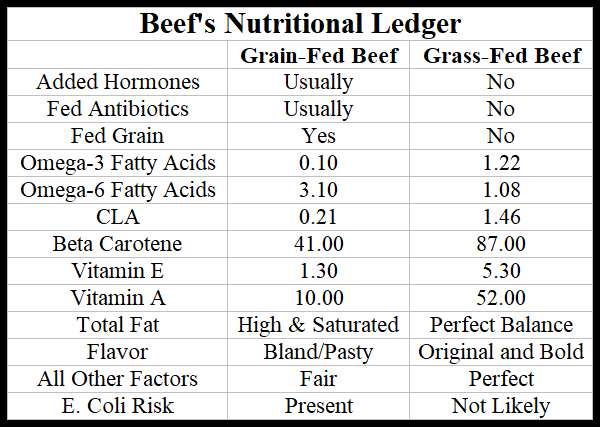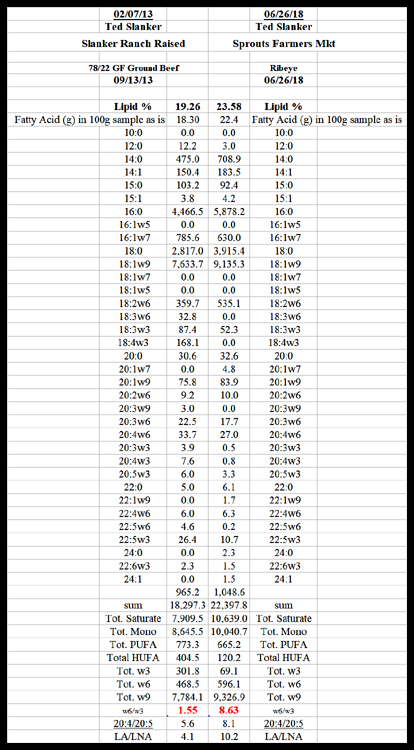Phony Grass-Fed
Column #151 July 13, 2018
Just like the “Natural” label, the meaning of the “Grass-Fed” label is now questionable. If your goal is to eat healthy foods, you’re in need of some tips on how to avoid being conned. When it comes to grass-fed meats, it’s buyer beware.
The slippery slope got underway with gusto in January 2016 when the USDA’s Agricultural Marketing Service revoked its approval process for use of its “grass-fed” beef marketing label. Since all beef cattle spend part of their life on pasture, many retailers just assume that being grass-fed at one time means grass-fed forever. Let me explain the consequences of that with a real life example of a grass-fed steak purchased from a large trusted retailer.
Linda and I were shopping for vegetables and fruit in Yukon, Oklahoma at the Sprouts Farmers Market. Per normal I checked out the meat department and their grass-fed steaks really caught my eye. They were very well marbled and looked similar to meats from Omaha Steaks. My immediate thought was that there’s no way these steaks are grass-fed.
The fresh meat pack I was eyeing was on a “Butcher’s Special” for a quick sale so I bought it. It’s now pictured with this column. I sent it to Lipid Technologies, LLC in Austin, Minnesota. That’s a professional lipid lab that is also home of the Omega-3 test. Their basic fatty acid test can determine if a steak is grass-fed or not. The detailed results are presented below.
“Grass-Fed” is supposed to refer to meat from pasture raised livestock that ate forages or, during inclement weather, were fed hay or grass silage. Of course cattle eat grass but they can also be fed grain. Since steaks from overly fat grain-fed animals are generally more tender, one can understand why the feedlot industry really came into its own after WWII when grain prices came down. Then by the 1960s the overly fat grain-fed meats were causing alarm because saturated fat was being associated with heart attacks. It wasn’t until some years later that scientists started reporting that grain feeding created an Omega-3 deficiency in meats and that was the reason for the heart disease link, not the saturated fats. To this day few people pay attention to the science.
When a steer is being fed grain, the Omega-6 content of its body goes up and its Omega-3 content goes down until it has the same high ratio as its grain-based diet. Depending on how much steers weigh when they go into a feedlot, they will spend anywhere from 100 to 200 days on feed with an average of around 170 days. A steer coming off pasture will have an Omega-6 to Omega-3 essential fatty acid (EFA) ratio that ranges from 0.6:1 to 2:1 with the average hovering around 1:1. The EFA ratios for finished grain-fed cattle are much higher.
Not only do grain-fed meats have high EFA ratios, but compared to grass-fed meats they are lower in many other nutrients too. In 2000 I put together this table illustrating these differences that I gleaned from a beef cattle report.
We know from a 2017 study by Andrew J. Young that humans on a controlled EFA balanced diet can see their EFA ratios change from 17.2:1 to 5.2:1 in five weeks and drop to 2.9:1 by the tenth week. When cattle are taken off pastures and fed a diet that’s 80% grain for 100 days, that’s 14.3 weeks. Understandably 100 days can easily shift their EFA ratios from 1:1 to 10:1. In 170 days it can be 15:1.
The ratio is critical for human health. Dr. Artemis Simopoulos underscores the importance of having a low EFA ratio thusly:
● Humans evolved with a ratio of Omega-6 to Omega-3 EFAs of 1:1.
● The ratio of Western diets is 15:1 to 17:1.
● Western diets are deficient in Omega-3 fatty acids.
● EFA ratios above 4:1 promote cardiovascular disease, cancer, and inflammatory and autoimmune diseases.
What Did the Sprouts Ribeye EFA Test Reveal?
The EFA ratio of the Sprouts ribeye was 8.63:1 which is typical for a steer on feed for 100 days. Since I’m focused on my health for all the reasons given by Dr. Simopoulos and thousands of scientists like her, then there’s no way I’d want to eat that Sprouts grass-fed ribeye steak. This also calls into question their relatively inexpensive “grass-fed” ground beef.
This next table compares the fatty acid data of 78/22 grass-fed ground meat from a steer I raised with the data from the Sprouts ribeye steak. For a better comparison in matching the high fat content (Lipid %) of the Sprouts steak I had to select our 78/22 ground beef. Take note that the grass-fed ground beef has more Omega-3 than the grain-fed steak and a greater presence of many long chain Omega-3 isomers like EPA, DPA, and DHA. Its low ratio of 1.55:1 indicates it is definitely grass-fed.

A legitimate grass-fed steak has the density, diversity, and balanced nutrient profile our bodies require for optimal function. The phony grass-fed steak has a nutrient profile that promotes cardiovascular disease, cancer, and inflammatory and autoimmune diseases.
The upshot of this is that you must get to know your vendors. Do they actually understand what’s required for optimizing health? Do they market food products based on meaningless labels such as free range, pastured, heritage, natural, organic, and others? These nice sounding labels are designed to lure people into buying something based on mere perceptions rather than reality. Scaremongering is also used by many to persuade people into buying something. Scientific literature and food chemistry are rarely used for marketing except to tout a single nutritional aspect of a food rather than its nutrient density and diversity, glycemic index, and EFA balance. But it’s obvious which approach is better for the consumer.
How many stores provide an EFA analysis of their meats? How many vendors provide their own personal EFA analysis? How many stores market their products based on science rather than popular myths? How many stores restrict their meat offerings to only Omega-3 meats? Omega-3 meats have EFA ratios of 2:1 or less. Maybe the disclosure of the Omega-3 ratio needs to replace the now meaningless “Grass-Fed” label.
To your health.
Ted Slanker
Ted Slanker has been reporting on the fundamentals of nutritional research in publications, television and radio appearances, and at conferences since 1999. He condenses complex studies into the basics required for health and well-being. His eBook, The Real Diet of Man, is available online.
Don't miss these links for additional reading:
Grass Fed Marketing Claim Standard by USDA
The USDA's Abdication of Defining 'Grass-Fed' Is Good For Consumers by Baylen Linnekin
You May Want to Think Twice Before Buying Expensive Grass-fed Beef by Julia Calderone
How Fast Can the EFA Ratio Change? By Ted Slanker
Blood Fatty Acid Changes in Healthy Young Americans in Response to a 10-week Diet That Increased N-3 and Reduced N-6 Fatty Acid Consumption: a Randomised Controlled Trial by Andrew J. Young et.al.
The Importance of the Ratio of Omega 6 Omega 3 Essential Fatty Acids by Artemis Simopoulos M.D.
Sprouts --The Butcher Shop 100% Grass Fed Boneless Rib Eye Steak
Ted Slanker’s Omega-3 Blood Test
Get Your Own Omega-3 Blood Test and use slanker as a code for a discount
Food Analysis: GI, GL, Fat Ratio, Nutrient Load by Ted Slanker




